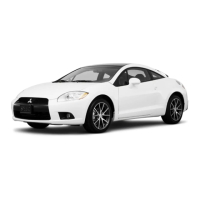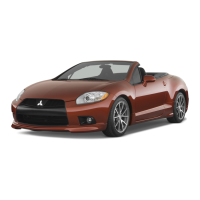CAUTION
•
When a vehicle in front is covered with
snow.
•
When a vehicle in front has a large glass
surface.
•
When a vehicle in front does not have re-
flectors (lamp reflector) or the position of
the reflector is low.
•
When a vehicle in front is a car carrier or
a similar shaped vehicle.
•
When there is a different object near the
vehicle.
•
When driving on a road with many and
successive curves, including when pass-
ing their entrances and outlets.
•
When accelerating and decelerating
quickly.
•
When the system recognizes driver’s
steering, accelerating, braking or gear
shifting actions as evasive actions to
avoid collision.
•
When you are driving on a road with
steep and alternating up and down slopes.
•
When driving on a slippery road covered
by rain water, snow, ice etc.
•
When a road surface is surging, and there
is unevenness.
•
When driving in dark areas, such as in a
tunnel or at night.
•
When your vehicle changed lanes, and
your vehicle approached immediately be-
hind the vehicle in front.
•
During a certain time after your vehicle
turns left or right.
CAUTION
•
When you are carrying extremely heavy
loads in the rear seats or luggage area.
•
After the engine has been running for an
extended period of time.
•
When using a windscreen washer.
•
If windscreen wipers are not
MITSUBISHI MOTORS GENUINE
parts or equivalent.
•
When the sensor becomes extremely hot
or cold.
•
If the battery becomes weak or runs
down.
•
When the sensor is affected by strong
light, such as direct sunlight or the head-
lamps of an oncoming vehicle.
•
Under adverse weather conditions (rain,
snow, sand storms, etc.)
•
When the windscreen of the sensor por-
tion is covered with dirt, water droplets,
snow and ice, etc.
•
When water, snow or sand on the road are
extorted by the vehicle in front or an on-
coming vehicle.
l
The FCM may not detect a pedestrian in cer-
tain situations. Some of these include:
•
It the pedestrian is shorter than approxi-
mately 1 m or taller than approximately
2 m.
•
If the pedestrian is wearing loose-fitting
clothes.
•
If part of a pedestrian’s body is hidden,
such as when holding an umbrella, large
bag, etc.
CAUTION
•
If a pedestrian bends forward, sits or lies
on the road.
•
When a pedestrian is pushing/pulling
something, such as a stroller, bicycle or
wheelchair.
•
When pedestrians gather in a group.
•
When a pedestrian’s clothing appears to
be nearly the same colour or brightness as
its surroundings.
•
When a pedestrian is very close to an ob-
ject, such as a vehicle.
•
When a pedestrian is in a dark area, such
as at night or in a tunnel.
•
When the pedestrian is walking fast or
running.
•
When a pedestrian suddenly rushes in
front of the vehicle.
•
When the position of a pedestrian is close
to the edge of the vehicle.
l
Factors such as the positional relationship
between your vehicle and a vehicle in front,
driver’s own technique of steering the vehi-
cle and irregularly moving traffic due to ac-
cidents or vehicle trouble may deter the
FCM control and alarm from functioning.
l
When the system recognizes driver’s steer-
ing or accelerating actions as evasive actions
to avoid a collision, the FCM control and
alarm functions may be cancelled.
l
The FCM control and alarm functions may
be triggered in the following situations.
Forward Collision Mitigation System (FCM)
6-81
OGKE18E1
Starting and driving
6

